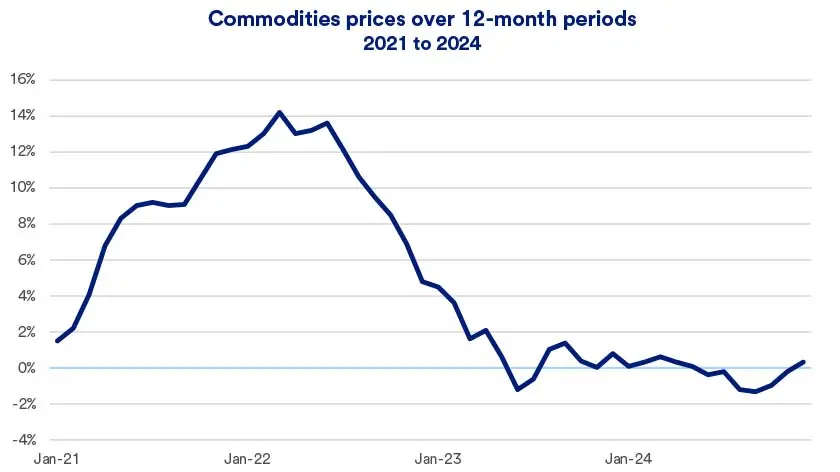Capitalize on today’s evolving market dynamics.
With markets in flux, now is a good time to meet with a wealth advisor.

Softer commodity prices have helped ease inflationary pressures on the U.S. economy.
Commodities comprise more than one-third of the Consumer Price Index, a widely cited measure of inflation.
Global economic growth trends often play a significant role influencing commodities markets.
Investors closely monitor commodity price trends to gauge the impact on inflation. In recent months, the Consumer Price Index (CPI) edged higher due in large part to commodity price changes. In late 2024, energy prices rose, and ended the year up 2.6% for the 12 months ending in December. The price uptick reflected lower inventory levels. Gold prices also increased, but since early 2024, most key agricultural commodities declined.
Dating back to mid-2022, lower commodity price growth contributed significantly to inflation’s retreat. Food price growth declined dramatically, and for most of 2024 until December, energy prices declined on a year-over-year basis. Will commodities continue to demonstrate stability, or are there risks of commodity price increases in the year ahead?
Commodities make up more than 35% of the CPI. After peaking at 9.1% for the 12-month period ending June 2022, CPI declined significantly, and as of the end of 2024, stands at 2.9% for the previous 12 months. Over the course of 2024, commodity prices as a whole rose just 0.3%.1

“People often look to commodities as an investment to help offset inflationary impacts, but inflation’s not a major issue in the current environment,” says Rob Haworth, senior investment strategy director for U.S. Bank Asset Management. “For investors, it’s a time to approach commodities markets with a sense of caution.”
Commodities represent a wide range of assets, including everything from energy and agricultural products to precious and industrial metals. Prices of different commodities can vary, though all tend to be affected by factors such as production levels (supply) and consumer and business demand. Economic factors also tend to come into play. For instance, during global economic recessions, energy demand tends to subside, often driving prices lower.
Economic factors likely affected recent commodity price trends. “We’re not getting enough demand growth today,” says Haworth. “There’s significant concern about economic growth in major global economies such as China and Japan that’s weighing on commodity markets.”
What is the likely direction of commodity prices going forward, and how might investors consider positioning their portfolios to reflect these trends?
Energy prices draw significant attention and are subject to significant volatility, often driven by world events. Since 2020, the market price for a barrel of crude oil ranged from a low of just above $10/barrel in the early days of the COVID-19 pandemic to as high as $120/barrel in the immediate aftermath of Russia’s 2022 invasion of Ukraine.2 “Lately, prices have fluctuated within a wide range, from the mid-$60s per barrel to the mid-$80s per barrel,” says Haworth.

“People often look to commodities as an investment to help offset inflationary impacts, but inflation’s not a major issue in the current environment."
Rob Haworth, senior investment strategy director, U.S. Bank Asset Management
President Donald Trump signed executive orders designed to open the door to more U.S. oil drilling and production. At the same time, markets anticipate that the Organization of Petroleum Exporting Countries (OPEC), will return to higher production levels, which were cut in 2024. “Both factors should help keep a lid on prices,” says Haworth.
On the other hand, efforts to refill the Strategic Petroleum Reserve (SPR) would boost demand. Haworth notes that the U.S. government, which tapped the SPR in times when oil prices soared, is now working on rebuilding its reserve. President Trump has stated his desire to completely fill the reserve. “We need 320 million more barrels to fill it,” says Haworth. Approximately 60 million barrels were added by the end of President Joe Biden’s term. At current price levels, it’s estimated that purchasing enough oil to completely fill the reserve would cost the U.S. government close to $25 billion.3 “A quicker refilling of SPR would take a significant increase in U.S. output, or the administration would need to tolerate higher purchase prices to reach this goal,” says Haworth.
At the end of 2024, the broad Bloomberg Commodity Index was virtually flat compared to the end of 2023. However, in 2025’s first three weeks, the Commodity Index rose 4.7%.3 Most prominent agricultural commodity prices declined since January 2024, with futures market wheat contracts 8.5% lower, and soybean prices down 14%. However, corn prices recently rallied, and rose 8% from mid-January 2024 levels.4 Lower prices for raw agricultural products contributed to a slowing of food price inflation.
Metals prices can be considered in two categories – precious metals such as gold and silver, and industrial metals used in manufacturing, such as nickel and copper for electric vehicle batteries. Gold prices dropped to a low of $1,831/ounce in October 2023, but by the end of October 2024 rose to more than $2,800/ounce, a jump of 53% in less than one year. Spot gold prices dropped in early November, but rallied recently, again approaching the $2,800/ounce level.
“While gold prices often rise in conjunction with inflation, the recent upturn in the face of inflation’s decline may have reflected significant global central bank gold demand,” says Haworth. “Central banks may now be waiting to see details of Trump administration policies before determining currency reserve plans.”
As for industrial metals, Haworth says supply concerns are an issue, particularly with more robust demand driven by increased production of electric vehicles. Minerals such as cobalt and nickel are key components for electric vehicle batteries. “We have longer-term supply issues,” says Haworth, “but in the near term, trade constraints such as tariffs have slowed demand.”
Investors sometimes consider including commodities as a portfolio hedge during inflationary periods. Higher inflation tends to enhance commodities’ attractiveness. “The challenge,” according to Haworth, “is that when you invest in a specific commodity, you have to get both decisions right – buying it cheap enough, and having the ability to sell it at a higher price.” Haworth notes that in the meantime, investors are not “paid” in the form of income while they wait for price appreciation.
Haworth says commodities are sometimes more effective as a tactical position in a portfolio. “It’s difficult to earn a durable return with direct investments in commodities or commodity futures,” he warns. “Given the state of today’s global economy, it’s not at all clear that the environment will result in higher, near-term commodity prices.”
Investors should be prepared for frequent changes, both higher and lower, in commodity prices. Talk with your financial professional about the appropriateness of a commodities position in your portfolio.
Commodity prices, such as crude oil and agriculture products, rose in 2021 and for part of 2022, partly due to supplies failing to keep pace with growing demand. Rising commodity prices contributed to increased inflation during that period. Through most of 2023 and 2024, commodity prices in general moderated, declining significantly from previous highs. This reflected improved supply and lagging demand, particularly for specific products such as oil and natural gas. Through April 2024, oil prices moved higher but have been in a trading range between the mid-$60 per barrel and mid-$80 per barrel range, according to the U.S. Energy Information Agency.
Typically, changes in commodity prices can drive inflation trends. According to the U.S. Bureau of Labor Statistics, commodities make up more than 35% of the Consumer Price Index, the most watched inflation measure. When inflation began to surge in 2021 and 2022, higher commodity prices, such as for food and gasoline, played a big role. When inflation numbers improved after peaking in mid-2022, declining energy prices and slowing food costs also played an important role.
Investors sometimes consider including commodities in a portfolio to hedge the impact of higher inflation. But it can be difficult to earn a durable return with direct investments in commodities or commodity futures. Investors must be aware that commodities tend to be a volatile asset class, and it is difficult to choose the right time to invest when prices can shift significantly in a short period of time. One effective way to capitalize on today’s commodities market is through investments in infrastructure. This includes companies involved in oil pipelines, airports, cell towers, toll roads and other forms of infrastructure. Along with capital appreciation potential, these investments also tend to provide a regular income stream.
There are multiple ways to invest in commodities, but the risks are high and the returns are unpredictable.
We can partner with you to design an investment strategy that aligns with your goals and is able to weather all types of market cycles.